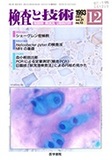Japanese
English
- 有料閲覧
- Abstract 文献概要
甲状腺ホルモン不応症候群は,体の組織が甲状腺ホルモンの作用に対して抵抗性を示す疾患である.全身型甲状腺ホルモン不応症(GRTH)は下垂体,そしてほとんどないしすべての末梢組織において抵抗性を示すのが特徴である.罹患した患者は血中甲状腺ホルモン値の上昇と,甲状腺ホルモンに比して不相応な正常ないし上昇した甲状腺刺激ホルモン(TSH)値を伴い,臨床的には甲状腺機能が正常であり,治療を必要としないのが一般的である.選択的下垂体甲状腺ホルモン不応症(PRTH)では抵抗性が下垂体のみに現れ,末梢組織では認められないことが特徴である.患者は血中甲状腺ホルモンの上昇と正常ないし上昇したTSH値を示し,臨床的には甲状腺中毒症を示す.選択的末梢性甲状腺ホルモン不応症(PerRTH)では末梢組織でのホルモン抵抗性はあるが,下垂体ではみられないのが特徴である.現在までに報告された唯一の症例では血中甲状腺ホルモンとTSH値は正常であるが,臨床的には甲状腺機能低下症を示し,甲状腺ホルモンの投与で改善がみられたと記述されている.これらの疾患はおそらく一般で認識されている以上に普遍的であろうし,しばしば誤診され,不適切に治療されているものと思われる.
The thyroid hormone resistance syndromes are disorders in which the body's tissues are resistant to the effects of thyroid hormone. Generalized resistance to thyroid hormone (GRTH) is characterized by resistance in the pituitary gland and in most or all of the peripheral tissues. Affected individuals have elevated serum thyroid hormone levels and inappropriately normal or elevated thyroid-stimulating hormone (TSH) but are usually clinically euthyroid and require no treatment. Selective pituitary resistance to thyroid hormone (PRTH) in characterized by resistance in the pituitary gland but not in peripheral tissues. Patients have elevated serum thyroid levels and normal or elevated TSH levels and are clinically thyrotoxic. Therapy is usually necessary, but current choices are not completely satisfactory. Selective peripheral resistance to thyroid hormone (PerRTH) is characterized by resistance in peripheral tissues but not in the pituitary. The only patient thus far described had normal serum thyroid hormone and TSH levels but was clinically hypothyroid and improved with thyroid hormone administration. All of these disorders are probably more common than is generally recognized and are often misdiagnosed and inappropriately treated.
Copyright © 1993, Igaku-Shoin Ltd. All rights reserved.


